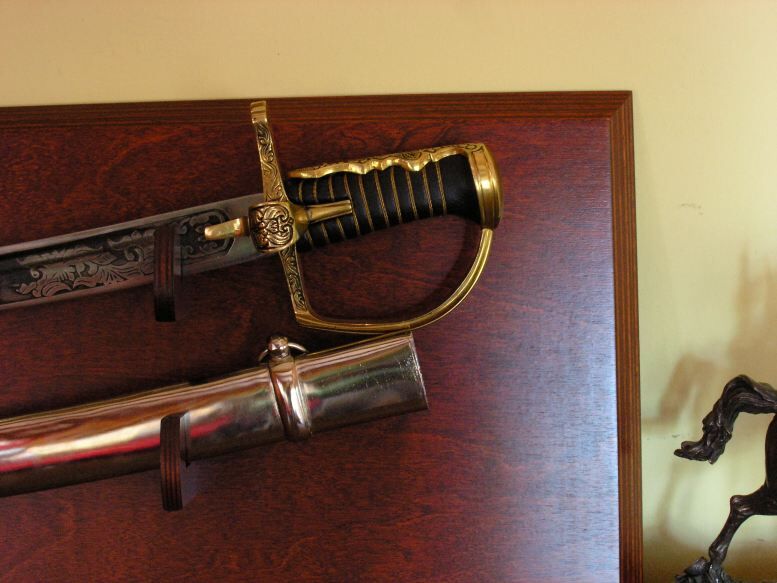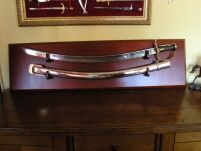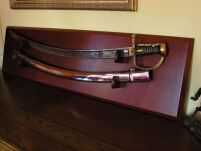



 Exists
Exists
The product is shipped within 24 hours.
We complete the order within 24 hours.
The product is covered by a one-year warranty.
You can return the product within 14 days.
POLISH SABRE hussar with FINGER from the seventeenth with scabbard with BOARD
Manufacturer: Spanish armourers (WZ 1750 / P)
Specifications:
Length: 95 cm
Weight: 2 kg
Hussar saber is a common definition of saber used by the Polish Cavalry (mostly by hussars) in the Polish-Lithuanian Commonwealth in the 17th and 18th century. The hussar saber was development of the Hungarian-Polish saber, common in 16th century Poland and connected the best features from the Western European and Turkish sabers.
It was ideal weapon for horseback fighting and allowed for fast and strong strikes. Heavy and closed hilt (extended cross-guard) offered good protection of the hand and much better control over the saber during a skirmish.
Additionally the metal thumb extended along the back-strap of the grip gives even greater control and comfort of using. The thumb-ring of brass or steel at the middle of the cross-guard enhanced the grip, give forceful downward swinging cuts and also facilitated faster recovery for the next cut. The cross-guard with moustache offered greater durability of the weapon by strengthening the joint between the blade and the hilt. The tip of the blade, called yelmen or feather, was in most cases double-edged and enable to thrusts.
Presented model is an exact replica of the original hussar saber.
On the one side of the blade is engraved "HUSSARIA" and on the other "JOSEF MARIA JESUS SPES MEA".
The set also includes a steel scabbard and wooden board.
Historical sketch:
History of saber in Polish military reaches the second half of the 15th century. It appeared in Poland under the influence of the Hungarians, who maintained contacts with Turks.
Initially it was only weapon of light cavalry and infantry, but even knights, who used sword in the battle, willing to use the saber while traveling, hunting and various festivals.
Above all, served them where they performed without armor, but wanted to have an effective weapon by side.
To the beginning of the 16th century saber gained a great popularity in Poland. Already in 1503, on the streets of Cracow people said, that no one wanted to buy swords, everyone preferred saber.
So quick growth of popularity of saber was related with military raids the Crimean Tatars into lands of Polish-Lithuanian Commonwealth. Tatars cavalry, armed with bows and sometimes also sabers were mostly highly mobile and uncatchable. They?re attacking in a small groups called besh-bash (five heads). The reception of saber into the polish army was necessity from the military point of view. An invasions of Crimean Khanate were especially often in 1474-1534 and in 1605-1633. Those raids, a lot of wars with Russia and also military alliance between Cossacks and Tatars (1648-1654) forced changes in the polish army, which extend beyond the armor modernization. After the reforms of polish parliament (sejm) in 1562 the vocational army called Permanent Defense (obrona potoczna) was replaced by quarter army (wojsko kwarciane) financed by a quarter of income from the regal land. Moreover at the beginnings of the 16th century developed new military formation called Old Polish Unit (stare urządzenie polskie). Two strongest detachments set one after the other were supported on the flanks by three lines of smaller detachments. At the second half of the 16th century to the unit included infantry and artillery.
The Polish Hussar, which at the beginning were light cavalry, at the half of the 16th century took over the role of lancers. Armored with a lance (only towarzysz), sabers, plate armour and helmets (often kettle hats), polish hussars were the base of polish army. From the 1630s the number of polish hussars were gradually reducing. Abandoned plate armour and replaced these with leopards and tigers skin leathers. They started to use pistols. In the 1690s, at the end of wars with Turks, the lances were replaced by muskets. The Polish Hussar proved to be the decisive factor in the spectacular wins in the following battles: battle of Curtea de Arges (1600), battle of Kircholm (1605), battle of Kłuszyn (1610), battle of Chocim (1621) and also battle of Vienna (1683). Polish Hussar existed to the half of the 18th century.